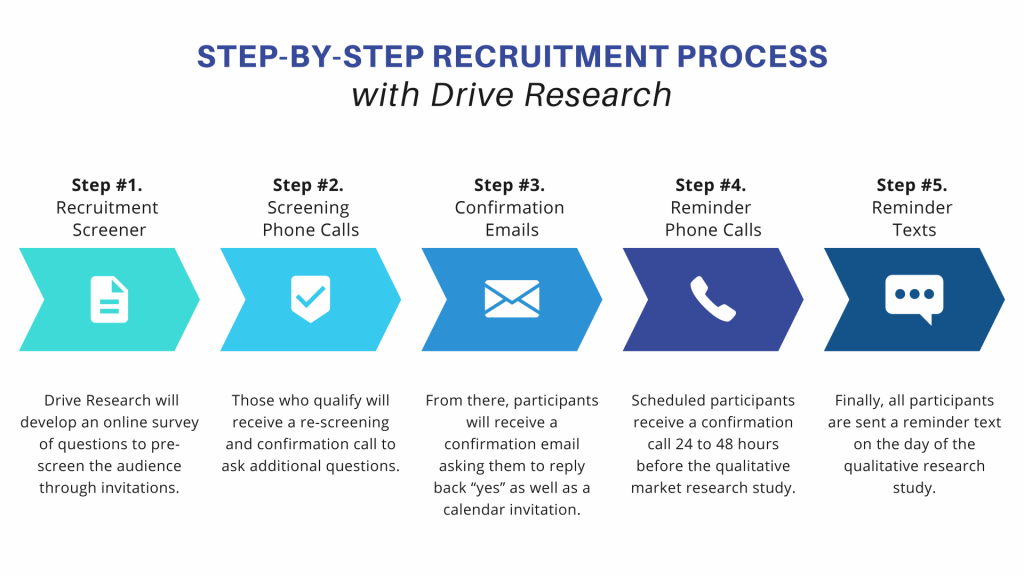
Qualitative research interviews (often called in-depth interviews or IDIs) are an excellent methodology to dig deep into a topic, product, service, or brand with your target audience.
They aim to fully explore mindsets and beliefs whereas quantitative surveys aim to measure.
In this post, our market research company will walk you through a 6 step process of conducting qualitative research interviews.
Article Contents
The qualitative interview steps we’ll discuss in this blog include:
- Defining objectives
- Gathering a list of targets
- Developing a recruitment screener
- Designing an interview guide
- Fieldwork
- Reporting
- Host a debrief meeting
Interested in conducting qualitative research interviews? Drive Research can help. Reach out to our team by using an online contact form or email us at [email protected].
Benefits of Qualitative Research Interviews
When discussing common forms of qualitative research, the two most popular methodologies mentioned are focus groups and in-depth interviews (IDIs).
Qualitative research interviews offer some value beyond a traditional focus group.
One of the benefits includes extended 1-on-1 time with the participants versus sharing 60 to 120 minutes among 4 to 12 focus group individuals.
In a focus group that lasts 90 minutes, each of the 9 participants would have an average of 10 minutes to speak.
Whereas with a 30 to 60-minute interview, you are maximizing the feedback you receive from each participant. It also allows the facilitator to dive deeper into discussion points and ask people to expand further on their points.
All of which offers the client more insight into what they are hoping to uncover in the market research project.
The Key Takeaway: When compared to focus groups, qualitative research interviews allow the moderator to spend more time with each participant. As a result, you are able to get more in-depth feedback from each person when compared to a group discussion.
Recommended Reading: Qualitative Battle: Focus Groups vs. In-Depth Interviews
Step #1: Define Your Objectives
You will not have any good market research outcomes unless you first understand your goals and objectives for the project.
Common market research objectives answer the following questions:
- What do you want to learn?
- How do you want to use the results?
- Who do you want to target for the interviews?
These and other secondary objectives need to be clearly defined in these initial stages.
Working with a qualitative research company will help you define these goals. The company will very likely put together a proposal for you with recommended methodologies based on your objectives.
After both your team and market research partner understand the goals of the research interview, a kickoff meeting is scheduled.
The main goal of the kickoff and defining your objectives is to help guide future steps. It will set the stage for recruitment, interview questions, and outcomes.
Although this is only the first step in the qualitative research interview process, it is also the most crucial.
The Key Takeaway: Perhaps the most important, yet underutilized component of conducting qualitative research interviews is taking the time to first define your objectives. Establishing clear objectives will help your market research partner draft questions that are most aligned with these goals.
Step #2: Gather Your List of Targets
After defining your objectives and understanding who you want to target, the next step is to define how you will pull those lists.
Here are a few key differences to keep in mind:
- Business-to-consumer (B2C) projects typically see an opt-in rate of 1:10, meaning you will need to dial at least 10+ records to schedule 1 interview.
- Business-to-Business ratios are more like 1:20 or higher. This varies from project to project and client to client.
We cover this topic in-depth here: Definition of B2C and B2B Market Research.
If you are conducting research interviews with customers or clients, you will likely have an in-house database list that contains email, phone numbers, and names. This is the easiest audience to reach and schedule.
However, if you want to interview non-customers, the process is more costly and challenging because in many cases, these targets have no relationship with your brand.
To acquire these lists you can purchase one through the following sources:
- Compile names and contacts through online secondary research (e.g. LinkedIn or online directory).
- Pull from your sales or prospect database (e.g. Salesforce).
- Partner with a market research panel company to recruit those who have vetted lists.
The Key Takeaway: Who are you looking to gather feedback from? Are there common demographics such as age, gender, job titles, etc.? While some audiences are more accessible than others, it is necessary to define your participant criteria before recruitment begins.
Step #3: Develop a Screener and Begin Recruitment
There are several benefits of pre-qualifying market research participants.
Trying to conduct interviews on the spot, particularly for B2B, can prove very challenging if your targets have a busy schedule.
Pre-planning and choosing a time shows that your market research company is organized and respectful of the target’s time.
In fact, our qualitative recruiting company has found that if you can set aside time with the participant they are even more willing to stay on the phone or talk to you in person longer.
Here is the process Drive Research follows when recruiting participants for qualitative research interviews.

Important of creating a recruitment screener
Once you have the list defined and the number of interviews you want to conduct, the next step is to develop a screener.
This screener lays out the recruitment criteria to qualify a participant. This could include questions like age, role or title, specific purchase behavior, etc.
The recruitment screener can be sent via email or be used through a live phone call to qualify participants. If the participant qualifies, the next step is taken to book the interview date and time.
The Key Takeaway: Drive Research recommends utilizing a screening survey to collect a large sample of qualified participants. By doing so, you can make follow-up phone calls to a list of people you know could make good fits for the study rather than flying blind.
Recommended Reading: Ultimate Guide to Recruiting Participants for Market Research
Step #4: Design an Interview Guide
Once the recruitment kicks off, you should begin your moderator guide design immediately.
Although you have a general sense of your goals and objectives from Step 1, here is where you become tactical and turn those high-level objectives into actual questions.
A guide is an excellent tool for the interviewer to keep the conversation on-topic and on time.
With an in-person or phone interview, much of the research is conversational.
Therefore you will likely have a fair share of open-ended questions in your script. Much more than a typical survey.
Keep in mind this will add time to the script. You should plan on about 1 question per minute (particularly for the open-ends).
This way if you have a 20-minute interview, you know that 20 questions (give or take) will keep you on time.
The Key Takeaway: Based on the objectives of the qualitative research interviews, a market research company such as Drive Research, designs a custom interview guide that includes key questions and discussion points for the study.
Step #5: Conduct the Interviews
The next step is fieldwork.
This is when you dial into a conference line or dial the participant directly (preferred).
Remember you want to eliminate as much work as possible and make it easy for the research participant. Calling them directly at your allotted time is easiest.
Then you follow your script and ask the respondent questions to address your key objectives.
If the participants end up elaborating on their open ends and talking at length, they’ll be likely to give you the benefit of the doubt if the interview runs over.
The first few questions involve some time of warm-up or easy questions to get the participant comfortable and to build rapport before moving into more depth.
The Key Takeaway: Now the real fun begins. In this step of the process, a trained interviewer meets with research participants in person, over the phone, or via Zoom. Here is where the in-depth feedback is gathered that will soon drive business decisions.
Recommended Reading: Basic Tips to Help With Your Next In-Depth Interview
Step #6: Develop Your Report
When conducting the research interviews, you have several options.
You can take notes in real-time, recap with notes following the interview, digitally record the interview, or have the interview transcribed.
Any or all of these are employed by interviewers and it truly depends on your style.
At our qualitative research company, we typically encourage our interviewers to record the conversations and recap notes after the interview.
This allows us to put 100% of our attention on the participant, actively listen, and ask natural follow-up questions — all of which is hard to do when you are trying to scribble down notes for each question asked.
The type of report can also vary from a high-level summary to a comprehensive deck.
- The topline summary typically pulls themes across all interviews and summarizes them into a short narrative report.
- The comprehensive report might include the executive summary but also goes into great detail with a section-by-section breakdown and quotes from participants.
Each has a corresponding cost associated with it from your qualitative market research firm.
The Key Takeaway: A market research report outlines the key insights and quotes gathered from the qualitative research IDIs. It is a deliverable that many clients use internally to help navigate the next steps they need to take with business, marketing, operations, and ROI-driven other strategies.
Recommended Reading: Topline Summary or Comprehensive Market Research Report: What’s the Difference?
Step #7: Host a Debrief Meeting
The last step when conducting qualitative research interviews is to debrief on the findings with key project stakeholders.
Our market research company typically spends an hour with our clients to walk through the report page by page.
It is a great time to dive into the results and offer actionable recommendations for how to use the data to drive decision-making.
We also spend this time answering any questions the client may have to assure they are confident in interpreting the findings long after the project is wrapped.
The Key Takeaway: In order to receive the true value of conducting qualitative research interviews, it is important the findings and insights are clear. Spend time with your market research partner to ensure you have a clear path forward for how to use the data to drive business, marketing, and sales strategies.
Conduct Qualitative Research Interviews with Our Team
When determining the best type of market research to utilize for your study’s objectives, it is important to talk to a market research expert.
These experienced industry professionals will guide you in choosing an approach, steering you to qualitative, quantitative, or both.
Drive Research is a national qualitative market research company.
We work with clients on both qualitative and quantitative custom-built research projects. Our scope of services spans all across the country and we even have several international clients.
Interested in receiving a proposal or quote for qualitative research? Contact us today.



